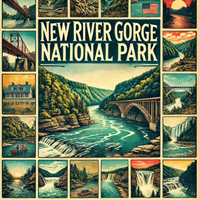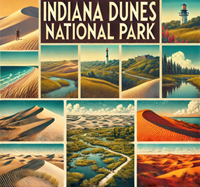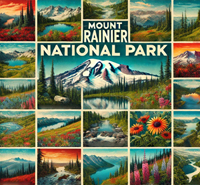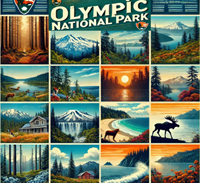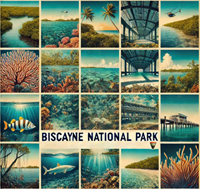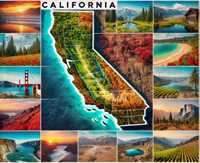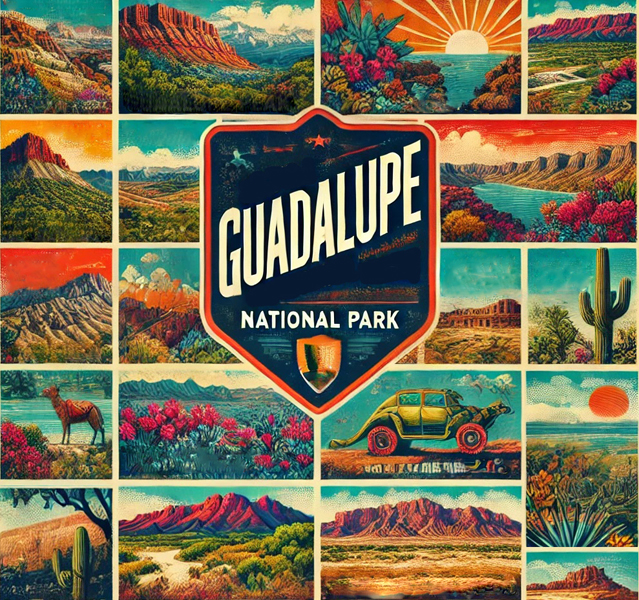

William and Hui Cha Stanek have meticulously crafted these national park guides, each showcasing the most stunning landscapes across the USA. But beyond the breathtaking scenery, these guides delve into the stories, experiences, and connections that make each park visit truly memorable.
National Parks Index | US Itineraries Index | American Roadtrips Index

Bring home a Bugville Critters book and watch as your child's love for reading and learning grows with every page. Hand-painted illustrations bring the heartwarming stories to life. Ask your librarian to add Bugville Critters to the library's digital collection today!
Discover William Stanek's Exclusive Art Collection
Explore and purchase the stunning art featured on this site. Own a piece of William Stanek's unique and captivating artwork today!
(May 2, 2025) Introducing Guadalupe Mountains National Park: Texas' Rugged High Country
Introduction to Guadalupe Mountains National Park
Guadalupe Mountains National Park is a rugged and remote treasure, where the highest peaks in Texas rise above the Chihuahuan Desert, offering some of the most stunning and unspoiled vistas I' ve ever seen. My first hike up to Guadalupe Peak, the highest point in Texas, was a challenging but deeply rewarding experience. The trail winds through diverse landscapes, from desert lowlands to forested slopes, culminating in breathtaking panoramic views from the summit. Standing at the top, with the vast desert stretching out below, gave me a profound sense of accomplishment and connection to the wild. Guadalupe Mountains is a place for those who seek solitude and the thrill of high adventure in a truly majestic setting.
How to Reach Guadalupe Mountains National Park
From the North (Carlsbad, NM): Travelers can take US-62/180 south directly to the park's Pine Springs entrance. The distance is approximately 55 miles, with a travel time of around 1 hour.
From the South (El Paso, TX): Visitors from El Paso can take US-62/180 east directly to the park. This route covers about 110 miles and takes around 2 hours.
From the East (Midland, TX): From Midland, take Interstate 20 west to Pecos, then follow US-285 south to US-62/180 west to the park. This journey spans approximately 180 miles and takes around 3.5 hours.
From the West (Alamogordo, NM): Travelers from Alamogordo can take US-54 south to El Paso, then follow US-62/180 east to the park. This route covers approximately 160 miles and takes around 3 hours.
Exploring Guadalupe Mountains: Must-Visit Sites
- Guadalupe Peak: The highest point in Texas, offering a challenging hike and stunning views.
- McKittrick Canyon: Known for its vibrant fall colors and diverse plant life.
- Salt Basin Dunes: White gypsum sand dunes providing a unique desert landscape.
- Dog Canyon: A remote area offering solitude and excellent hiking opportunities.
Seasonal Variations
Guadalupe Mountains offers unique experiences in each season:
- Spring: Wildflowers bloom, and moderate temperatures create perfect hiking conditions.
- Summer: Despite the heat, higher elevations offer cooler temperatures and pleasant exploration opportunities.
- Fall: Brilliant fall foliage in McKittrick Canyon provides a stunning contrast to the rugged landscape.
- Winter: Mild winter temperatures and fewer crowds create a peaceful environment.
Visitor Updates for Guadalupe Mountains National Park
Conservation Efforts
William Stanek's photography in Guadalupe Mountains highlights the park's diverse landscapes and the importance of preserving its unique ecosystems. His work supports efforts to protect the park from the impacts of climate change, development, and human activity.
1 Day at Guadalupe Mountains National Park: Texas's Rugged High Country
Introduction
Guadalupe Mountains National Park, located in western Texas, is known for its rugged peaks, diverse ecosystems, and historic landmarks. Here's a detailed guide to making the most of your visit, with expert tips from William and Hui Cha Stanek.
Morning: Sunrise and Scenic Drives
6:00 AM - Sunrise at Guadalupe Peak
- Overview: Start your day with a breathtaking sunrise from the top of Guadalupe Peak, the highest point in Texas.
- Tips from William: Arrive early to set up your tripod and capture the sunrise over the mountains. Use a wide-angle lens to encompass the entire landscape.
- Insights from Hui Cha: Dress warmly and bring a thermos of hot coffee or tea. The early morning mountain air can be chilly.
7:30 AM - Breakfast at Pine Springs
- Overview: Head to Pine Springs Visitor Center for a quick breakfast and to gather information about the park.
- Tips from William: Capture the morning light on the surrounding peaks and the visitor center's architecture.
- Insights from Hui Cha: Enjoy a hearty breakfast to fuel your day. Grab some snacks and water for later.
Mid-Morning: Scenic Drives and Short Hikes
8:30 AM - McKittrick Canyon
- Overview: Drive to McKittrick Canyon, known for its stunning fall foliage and scenic beauty.
- Tips from William: Stop frequently to capture the stunning vistas. Use a polarizing filter to reduce glare and enhance the colors of the landscape.
- Insights from Hui Cha: Take your time and enjoy the drive. The road can be narrow and winding, so drive carefully.
10:00 AM - McKittrick Canyon Trail
- Overview: Hike the McKittrick Canyon Trail to see the Pratt Cabin and the Grotto.
- Tips from William: Use a wide-angle lens to capture the expansive views. The mid-morning light is perfect for photography.
- Insights from Hui Cha: The trail is moderately strenuous, so wear sturdy hiking shoes and bring plenty of water. The views along the trail are worth the effort.
Afternoon: Historic Sites and Wildlife Viewing
12:30 PM - Picnic Lunch at Dog Canyon
- Overview: Enjoy a packed lunch at Dog Canyon, a secluded area with stunning views of the surrounding landscape.
- Tips from William: Capture candid moments of your picnic with the beautiful backdrop.
- Insights from Hui Cha: Pack a nutritious and energizing meal. Take a moment to relax and enjoy the natural surroundings.
1:30 PM - Frijole Ranch
- Overview: Visit the Frijole Ranch, a historic ranch that now serves as a museum.
- Tips from William: Use a wide-angle lens to capture the historic buildings and surrounding scenery. The afternoon light enhances the colors and textures.
- Insights from Hui Cha: The ranch offers a fascinating glimpse into the past. Take your time exploring the buildings and learning about the history.
3:00 PM - Smith Spring Loop Trail
- Overview: Hike the Smith Spring Loop Trail, a 2.3-mile trail that offers diverse scenery and wildlife viewing.
- Tips from William: Use a telephoto lens to capture distant wildlife and the lush spring area. Late afternoon light enhances the textures and colors.
- Insights from Hui Cha: The area is rich in wildlife, so be prepared with binoculars and a camera. Enjoy the scenic trails and viewpoints.
Late Afternoon: Photography and Relaxation
4:30 PM - Devil's Hall Trail
- Overview: Hike the Devil's Hall Trail, a 4.2-mile round trip trail that leads to a narrow canyon.
- Tips from William: Use a wide-angle lens to capture the dramatic cliffs and the narrow canyon. Experiment with different compositions and perspectives.
- Insights from Hui Cha: The hike is moderately strenuous but offers incredible views. Bring water and take breaks as needed.
Evening: Sunset and Dinner
6:00 PM - Sunset at El Capitan Viewpoint
- Overview: Head to El Capitan Viewpoint for a stunning sunset view over the mountains.
- Tips from William: Use a graduated neutral density filter to balance the exposure. Experiment with long exposures to capture the changing light.
- Insights from Hui Cha: Arrive early to find a good spot. Bring a light jacket as it can get cool after sunset.
7:30 PM - Dinner in Pine Springs
- Overview: Return to Pine Springs for a relaxing dinner at a local restaurant.
- Tips from William: Capture the evening atmosphere of the small area. Try some local Texas cuisine to end your day.
- Insights from Hui Cha: Reflect on the day's adventures and enjoy a hearty meal. Pine Springs offers a variety of dining options with a welcoming atmosphere.
Guadalupe Mountains National Park (Texas)
Guadalupe Mountains National Park, located in western Texas, is home to the highest peaks in the state, including the iconic Guadalupe Peak. Covering over 86,000 acres, the park features rugged mountains, desert landscapes, and lush canyons, offering diverse opportunities for hiking, wildlife viewing, and photography.
Park History and Cultural Significance:
- Established as a national park in 1966, Guadalupe Mountains protects significant natural and cultural resources, including the remnants of an ancient reef from the Permian period.
- The area has a rich history of Native American habitation, particularly by the Mescalero Apache, as well as Spanish explorers and early American settlers.
Visitor Centers and Facilities:
- Pine Springs Visitor Center: Offers exhibits on the park's natural and cultural history, a park film, maps, information, restrooms, and a gift shop.
- McKittrick Canyon Visitor Center: Provides exhibits, maps, information, and restrooms.
- Campgrounds: The park has several campgrounds, including Pine Springs and Dog Canyon, offering basic amenities like restrooms and picnic tables.
Best Times to Visit:
- Spring (March to May): Ideal for moderate temperatures and wildflower blooms.
- Fall (September to November): Offers cooler temperatures and fewer crowds, with stunning fall foliage in McKittrick Canyon.
- Summer (June to August): Can be hot, especially in lower elevations. Early morning and late evening activities are recommended.
- Winter (December to February): Offers solitude and cooler temperatures, but weather can be unpredictable.
Activities and Recreation:
- Hiking: Trails range from easy walks to challenging hikes, including the Guadalupe Peak Trail, McKittrick Canyon Trail, and Devil's Hall Trail.
- Wildlife Watching: Opportunities to see mule deer, elk, black bears, and a variety of bird species.
- Scenic Drives: The drive to McKittrick Canyon offers stunning views of the park's landscapes.
- Camping: Campgrounds provide opportunities for both frontcountry and backcountry camping.
- Photography: The park's rugged landscapes provide endless opportunities for photography, particularly at sunrise and sunset.
Accessibility Information:
- The Pine Springs Visitor Center and McKittrick Canyon Visitor Center are wheelchair accessible.
- Accessible trails include the Pinery Trail.
- Accessible campgrounds and restrooms are available throughout the park.
Permits and Regulations:
- Entrance Fees: Required for entry; passes can be purchased online or at park entrances.
- Camping Permits: Required for camping at designated campgrounds. Reservations are recommended during peak seasons.
- Backcountry Permits: Required for overnight stays in backcountry areas.
- Special Use Permits: Needed for activities such as weddings, commercial filming, and large group gatherings.
Nearby: Carlsbad Caverns National Park, Sitting Bull Falls
-
Carlsbad Caverns National Park: About 30 minutes from Guadalupe Mountains, this park features an extensive cave system with stunning limestone formations.
- Activities: Cave tours, hiking, bat watching.
- Notable Sites: Big Room, King's Palace.
- Wildlife: Cave-dwelling species, bats, mule deer.
-
Sitting Bull Falls: About an hour from Guadalupe Mountains, this recreation area features a beautiful waterfall cascading over travertine rock.
- Activities: Hiking, picnicking, swimming.
- Notable Sites: Sitting Bull Falls.
- Wildlife: Mule deer, various bird species, lizards.
Important Updates for Guadalupe Mountains National Park
Guadalupe Mountains National Park (Texas)
Local Attractions and Surrounding Areas:
Guadalupe Mountains National Park, located in west Texas, is known for its rugged mountain landscapes, diverse ecosystems, and rich history. The nearby town of Carlsbad, New Mexico, serves as the primary gateway to the park, providing a variety of amenities including lodging, dining, and shops. Carlsbad is home to the Carlsbad Caverns National Park, which offers stunning underground formations and extensive cave systems.
Further afield, the city of El Paso, Texas, offers additional amenities and attractions, including the El Paso Museum of Art, the El Paso Zoo, and the historic Mission Trail. El Paso also serves as a gateway to the Franklin Mountains State Park, which offers additional opportunities for hiking, rock climbing, and exploring the region's rugged landscapes.
Nearby Attractions
Guadalupe Mountains National Park is surrounded by numerous attractions that enhance the visitor experience. Here are some must-see local attractions:
-
Guadalupe Peak: The highest point in Texas at 8,751 feet, offering stunning panoramic views of the surrounding landscape. The challenging hike to the summit is rewarding for its breathtaking vistas.
-
McKittrick Canyon: Known as the most beautiful spot in Texas, McKittrick Canyon features a vibrant display of fall foliage, a year-round stream, and historic structures such as the Pratt Cabin and the Grotto.
-
Salt Basin Dunes: Located in the western part of the park, these white gypsum sand dunes contrast sharply with the surrounding desert landscape. They are best visited in the cooler parts of the day.
-
Dog Canyon: A remote and scenic area on the northern edge of the park, offering excellent opportunities for hiking, camping, and wildlife viewing.
-
Frijole Ranch: A historic ranch site featuring a museum with exhibits on the area's cultural and natural history. The ranch also serves as a trailhead for several hikes.
-
El Capitan: A prominent limestone peak that serves as a landmark for travelers. It is particularly striking at sunset when it glows with a reddish hue.
Nearby Towns and Cities
Visitors to Guadalupe Mountains National Park can find additional amenities and activities in nearby towns and cities:
-
Carlsbad, New Mexico: Located about 40 miles north of the park, Carlsbad offers accommodations, dining, and attractions such as Carlsbad Caverns National Park, the Living Desert Zoo and Gardens State Park, and Lake Carlsbad Beach Park.
-
Van Horn, Texas: Located about 60 miles south of the park, Van Horn offers basic amenities including lodging, dining, and access to the Red Rock Ranch and Clark Hotel Museum.
-
El Paso, Texas: Located about 110 miles southwest of the park, El Paso offers extensive amenities, including hotels, restaurants, museums, and attractions like the El Paso Museum of Art, the El Paso Zoo, and Franklin Mountains State Park.
-
Alamogordo, New Mexico: Located about 150 miles north of the park, Alamogordo offers accommodations, dining, and attractions such as the New Mexico Museum of Space History and White Sands National Park.
-
Pine Springs: The closest community to the park's main entrance, Pine Springs offers basic amenities and serves as a base for park visitors.
Scenic Drives
Guadalupe Mountains National Park boasts several scenic drives that offer unparalleled views of the park's unique landscapes. These drives are perfect for capturing the essence of the park through photography.
-
Guadalupe Peak Scenic Drive (U.S. Highway 62/180):
- Details: This highway runs along the southern edge of the park, offering stunning views of the Guadalupe Mountains, including El Capitan and Guadalupe Peak.
- Key Stops: Highlights include the Pine Springs Visitor Center, the Guadalupe Peak Trailhead, and the various pullouts along the highway.
- Photography Tips: William Stanek suggests stopping at the pullouts along the highway to capture different perspectives of the mountains. Early morning and late afternoon provide the best lighting for photography.
-
Salt Basin Dunes Road:
- Details: This gravel road leads to the Salt Basin Dunes, offering views of the white gypsum sand dunes against the backdrop of the Guadalupe Mountains.
- Key Stops: Highlights include the Salt Basin Dunes trailhead and several scenic pullouts along the road.
- Photography Tips: Hui Cha Stanek recommends using a wide-angle lens to capture the expansive views of the dunes. The best times for photography are during the golden hours of sunrise and sunset.
-
McKittrick Canyon Road:
- Details: This short scenic drive leads to the McKittrick Canyon trailhead, offering views of the canyon and the surrounding mountains.
- Key Stops: Highlights include the McKittrick Canyon trailhead and the McKittrick Canyon Visitor Center.
- Photography Tips: The Staneks suggest using a polarizing filter to enhance the colors of the canyon and sky. Early morning and late afternoon provide the best light for photography.
Reservations and Timed Entry Information
Click the link to see updates. Wait up to 30 seconds for results.
Best Hikes
Guadalupe Mountains National Park offers a variety of hiking trails that cater to all skill levels. Each trail provides unique opportunities for exploration and photography. Here are some of the best hikes in the park:
-
Guadalupe Peak Trail:
- Details: This 8.5-mile round-trip trail ascends to the summit of Guadalupe Peak, the highest point in Texas. The trail is strenuous and offers stunning views of the park and surrounding areas.
- Key Viewpoints: Highlights include the views from the summit of Guadalupe Peak and the vistas along the trail.
- Photography Tips: William Stanek recommends starting early in the morning to capture the best light and avoid the afternoon heat. A wide-angle lens is ideal for capturing the expansive views from the summit.
-
McKittrick Canyon Trail:
- Details: This 7.6-mile round-trip trail follows a year-round stream through McKittrick Canyon, offering beautiful views of the canyon's fall foliage, rock formations, and historic structures.
- Key Viewpoints: Highlights include the Pratt Cabin, the Grotto, and the stunning views of the canyon.
- Photography Tips: Hui Cha Stanek suggests using a polarizing filter to enhance the colors of the foliage and sky. Early morning and late afternoon provide the best light for photography.
-
Devil's Hall Trail:
- Details: This 4.2-mile round-trip trail leads hikers through Pine Spring Canyon to the stunning Devil's Hall, a natural rock formation with impressive geological features.
- Key Viewpoints: The main attraction is Devil's Hall, with its narrow canyon walls and unique rock formations.
- Photography Tips: The Staneks recommend using a wide-angle lens to capture the narrow canyon walls and a tripod for long exposure shots. Early morning and late afternoon provide the best light for photography.
-
Smith Spring Loop Trail:
- Details: This 2.3-mile loop trail starts at the Frijole Ranch and leads to the lush Smith Spring, offering a beautiful contrast to the surrounding desert landscape.
- Key Viewpoints: Highlights include Smith Spring and the views of the surrounding desert and mountains.
- Photography Tips: William Stanek suggests using a macro lens to capture the details of the flora around Smith Spring. Early morning and late afternoon provide the best light for photography.
-
Dog Canyon Trail:
- Details: This 6.4-mile round-trip trail starts at Dog Canyon and leads through a scenic, remote area of the park, offering beautiful views of the canyon and the surrounding mountains.
- Key Viewpoints: Highlights include the views of Dog Canyon and the diverse landscapes along the trail.
- Photography Tips: Hui Cha Stanek recommends using a telephoto lens to capture distant views and wildlife along the trail. Early morning and late afternoon provide the best light for photography.
-
Tejas Trail:
- Details: This 6.2-mile round-trip trail offers beautiful views of the Pine Springs Canyon and the surrounding mountains. The trail is moderately strenuous.
- Key Viewpoints: Highlights include the views from Pine Top and the diverse flora along the trail.
- Photography Tips: The Staneks suggest using a wide-angle lens to capture the expansive views along the trail. Early morning and late afternoon provide the best light for photography.
-
Bush Mountain Trail:
- Details: This 13.1-mile round-trip trail leads to the summit of Bush Mountain, offering stunning views of the surrounding mountains and valleys. The trail is strenuous and requires good physical fitness.
- Key Viewpoints: Highlights include the summit of Bush Mountain and the vistas along the trail.
- Photography Tips: William Stanek recommends using a polarizing filter to enhance the colors of the landscape. Early morning and late afternoon provide the best light for photography.
Other Hikes:
-
Bowl Trail: This challenging 9.1-mile loop takes hikers through the high country of the Guadalupe Mountains, offering stunning views of the surrounding peaks, forests, and valleys. The trail features steep climbs, rugged terrain, and beautiful vistas. Key points of interest along the trail include the Bowl, the Hunter Peak, and the Tejas Trail junction. William suggests this hike for experienced hikers looking for a remote and rewarding adventure.
-
Permian Reef Trail: This 8.4-mile round trip hike is moderately difficult and takes hikers through the scenic McKittrick Canyon to the Permian Reef, offering stunning views of the canyon's geology and unique rock formations. The trail features interpretive signs that provide information about the Permian Reef and the park's geological history. Key points of interest along the trail include the McKittrick Canyon Trail junction and the Permian Reef Overlook. Hui Cha highlights this hike for its educational value and the opportunity to learn about the park's rich geological history.
William and Hui Cha Stanek's deep connection with Guadalupe Mountains National Park is evident in their extensive body of work. William's technical prowess with cameras and lenses, combined with Hui Cha's artistic eye, creates a dynamic partnership that brings the park's beauty to life. They emphasize the importance of timing and light in landscape photography, often spending hours waiting for the perfect conditions to capture the essence of the park.
Their commitment to conservation is also a significant aspect of their work. Through their photography and writings, they strive to raise awareness about the importance of preserving natural landscapes like Guadalupe Mountains National Park. They support organizations such as the National Park Foundation and the Sierra Club, advocating for responsible tourism and environmental stewardship.
Conclusion
Guadalupe Mountains National Park, with its rugged landscapes and diverse ecosystems, offers endless opportunities for exploration and photography. The local attractions, scenic drives, and hiking trails provide a comprehensive experience for visitors. Through the lens of William and Hui Cha Stanek, the park's beauty and significance are captured and shared, inspiring others to appreciate and protect this natural wonder. Whether you are a seasoned photographer or a casual visitor, Guadalupe Mountains National Park promises a memorable and enriching adventure.

Step into a world of timeless beauty with our premium, oversized hardcover book - crafted for discerning collectors and anyone who values the power of art. Perfect for your coffee table, it's more than just a book; it's a conversation starter, a window into over 30 years of William's visionary photography.
Your Support Matters
Purchasing artwork from William Stanek's collection not only brings beauty into your life but also helps us continue to share. Thank you for supporting our creative journey!

Support The Lights of Paris by Robert Stanek, William Stanek's pen name! Through vivid historical detail and deeply moving character stories, Robert takes readers on an unforgettable journey through one of history’s most transformative times.


